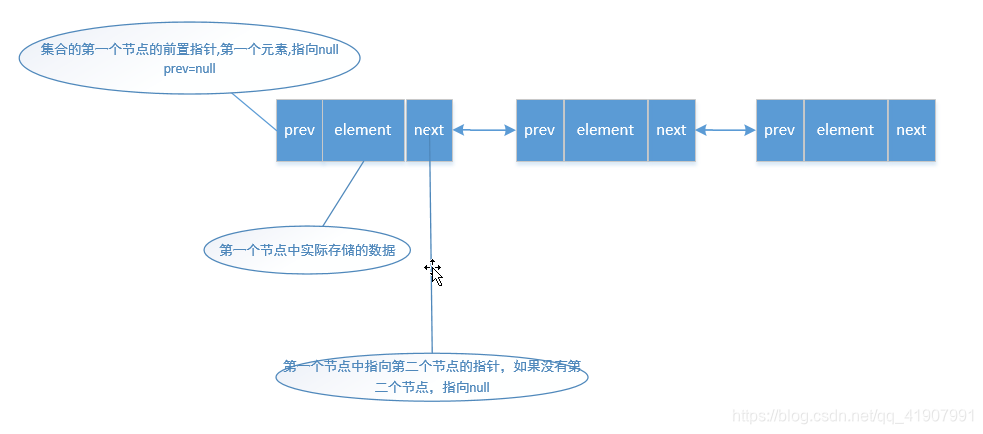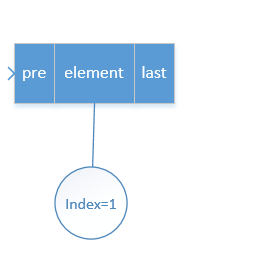文章目录
LinkedList:
继承关系分析:
public class LinkedList<E>
extends AbstractSequentialList<E>
implements List<E>, Deque<E>, Cloneable, java.io.Serializable
这里的Cloneable,Serializable,List这三个接口就不多赘述了,之前在介绍ArrayList的时候已经说过了。主要分析下AbstractSequentialList跟Deque
-
AbstractSequentialList
AbstractSequentialList 实现了get(int index)、set(int index, E element)、add(int index, E element) 和 remove(int index)这些函数。LinkedList是双向链表;既然它继承于AbstractSequentialList,就相当于已经实现了“get(int index)这些接口”
-
Deque
实现了Deque接口,代表LinkedList能被当作双端队列使用
字段分析:
// 长度
transient int size = 0;
// 头节点
transient Node<E> first;
// 尾节点
transient Node<E> last;
// 继承了AbstractSequentialList,AbstractSequentialList又继承了AbstractList
protected transient int modCount = 0;
构造函数分析:
public LinkedList() {
}
public LinkedList(Collection<? extends E> c) {
this();
addAll(c);
}
方法分析:
-
add,我们主要看这两个重载的方法
// 往末尾添加元素 public boolean add(E e) { linkLast(e); return true; } // 往头部添加 public void addFirst(E var1) { this.linkFirst(var1); } // 往指定位置添加元素 public void add(int index, E element) { // 判断角标是否越界 checkPositionIndex(index); // 说明是往尾部添加元素 if (index == size) linkLast(element); else // 往集合中添加元素 linkBefore(element, node(index)); }跟踪方法到,linkLast(e)。
void linkLast(E e) { // 申明一个Node,保存last的引用 final Node<E> l = last; // 创建一个新节点,pre指向集合的last,next指针指向null,也即是集合的尾指针 final Node<E> newNode = new Node<>(l, e, null); // 集合的尾指针指向新节点 last = newNode; if (l == null) // 说明集合刚刚初始化,一个元素都没有,添加的是第一个元素 first = newNode; else // 集合中原来的最后一个节点的next指针指向了新节点 l.next = newNode; // 集合长度加1 size++; // 集合修改次数加1 modCount++; }用图形的方式我们分析下这个过程:
假设我们现在有一个三个元素的集合,如下:

现在我们要调用add方法往集合的尾部添加一个元素:
- 创建一个节点

- 需要将这个节点的pre指针指向当前集合的最后一个元素,同时将当前集合的最后一个元素的next指针指向这个新增的节点
- 创建一个节点

- 不要忘了,在添加后,我们集合的last指针也变成了我们新增的这个元素的next指针
上面我们分析了往尾部添加一个元素的情况,往头部添加一个元素就不多追诉了,那么往集合中添加一个元素呢?
我们先看下源码:
首先调用了node方法
Node<E> node(int index) {
// 这里主要是判断是离头部比较近还是离尾部比较近
// 如果头部比较近就从头节点开始搜索,否则就尾节点开始搜索
if (index < (size >> 1)) {
Node<E> x = first;
for (int i = 0; i < index; i++)
// 一直搜索到指定位置
x = x.next;
// 然后返回这个指定位置上的元素
return x;
} else {
Node<E> x = last;
for (int i = size - 1; i > index; i--)
x = x.prev;
return x;
}
}
之后调用linkBefore方法
// e:要添加的节点
// succ: 当前位置上的节点
// 这个方法主要就是将e添加到succ节点的前一个节点位置上
void linkBefore(E e, Node<E> succ) {
// assert succ != null;
// 用pred指针指向succ的前一个节点
final Node<E> pred = succ.prev;
// 创建一个新节点,pre指针指向succ的前一个节点,next指针指向succ,节点元素为e
final Node<E> newNode = new Node<>(pred, e, succ);
// succ的pre指针指向新增的节点
succ.prev = newNode;
// 如果succ.prev==null,说明succ是头节点,所以添加后,我们新增的节点就是头节点
if (pred == null)
first = newNode;
else
// 否则的话,就将succ的前一个节点的next指针指向新增的节点
pred.next = newNode;
// 集合长度+1
size++;
// 修改次数加+1
modCount++;
}
我们也用图形的方式来描述下这个过程:
假设我们现在有一个三个元素的集合,如下:
我们要在index=1的位置上新增一个元素,也就是调用add(1,“新元素”)
-
我们要获取到index=1的这个位置上的元素,通过源码我们知道,会通过头节点遍历到第二个节点后,返回给我们这个节点,也就是node方法

-
因为我们要在index=1的位置上插入元素,所以,我们要将index=0位置上的元素的next指针指向我们新增的元素,同时我们要新增的节点的pre指针指向头节点,另外,新增节点的next指针指向原index=1上位置的节点,index=1位置上的节点的pre指针指向我们新增的节点

-
get方法
public E get(int index) { checkElementIndex(index); // get就是调用我们之前分析过的node方法 // 获取指定位置上的节点,然后返回节点保存的元素 return node(index).item; } -
对比ArrayList我们也分析下迭代器
跟踪源码我们可以发现,核心就是下面这个内部类
private class ListItr implements ListIterator<E> { // 记录当前迭代器最后一个返回的节点 private Node<E> lastReturned; // 下一个迭代的节点 private Node<E> next; // 下一个迭代的节点的索引位置 private int nextIndex; // 快速失败机制 private int expectedModCount = modCount; // 创建一个从指定位置开始迭代的迭代器 ListItr(int index) { // assert isPositionIndex(index); next = (index == size) ? null : node(index); nextIndex = index; } public boolean hasNext() { return nextIndex < size; } // 返回准备迭代的元素 public E next() { checkForComodification(); if (!hasNext()) throw new NoSuchElementException(); // 记录返回的节点 lastReturned = next; // 记录迭代器将要迭代的下一个节点 next = next.next; // 索引+1 nextIndex++; return lastReturned.item; } public boolean hasPrevious() { return nextIndex > 0; } public E previous() { checkForComodification(); if (!hasPrevious()) throw new NoSuchElementException(); lastReturned = next = (next == null) ? last : next.prev; nextIndex--; return lastReturned.item; } public int nextIndex() { return nextIndex; } public int previousIndex() { return nextIndex - 1; } // 分析下这个方法中的unlink方法 public void remove() { checkForComodification(); if (lastReturned == null) throw new IllegalStateException(); Node<E> lastNext = lastReturned.next; // 移除上一次迭代的节点 unlink(lastReturned); // 说明通过previous()方法迭代 if (next == lastReturned) // 这个时候nextIndex不用发生变化 next = lastNext; else // 因为移除了一个元素,所以nextIndex需要减1 nextIndex--; lastReturned = null; expectedModCount++; } public void set(E e) { if (lastReturned == null) throw new IllegalStateException(); checkForComodification(); lastReturned.item = e; } public void add(E e) { // 快速失败机制检查 checkForComodification(); lastReturned = null; if (next == null) linkLast(e); else linkBefore(e, next); nextIndex++; expectedModCount++; }// 用于将元素从集合中移除 // 其实做的就是,将这个节点的pre指针指向的节点的next指针指向这个节点的next指针指向的节点 // 同时将这个节点的next指针指向的节点的pre指针指向这个节点的pre指针指向的节点 E unlink(Node<E> x) { // assert x != null; final E element = x.item; final Node<E> next = x.next; final Node<E> prev = x.prev; if (prev == null) { first = next; } else { prev.next = next; x.prev = null; } if (next == null) { last = prev; } else { next.prev = prev; x.next = null; } x.item = null; size--; modCount++; return element; }图片描述如下:

